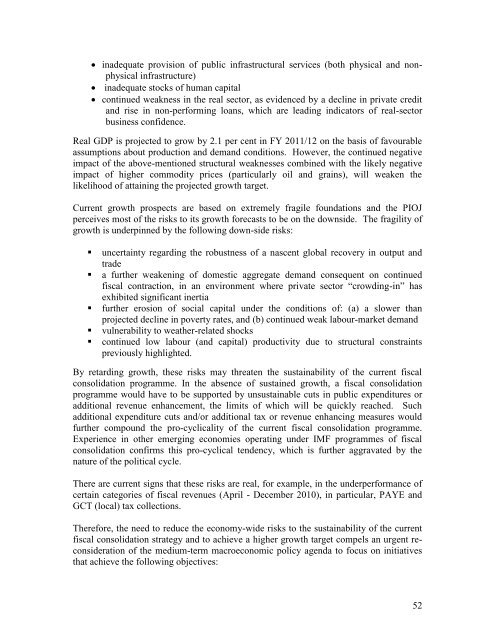PIOJ Growth-Inducement Strategy - Planning Institute of Jamaica
PIOJ Growth-Inducement Strategy - Planning Institute of Jamaica
PIOJ Growth-Inducement Strategy - Planning Institute of Jamaica
You also want an ePaper? Increase the reach of your titles
YUMPU automatically turns print PDFs into web optimized ePapers that Google loves.
inadequate provision <strong>of</strong> public infrastructural services (both physical and nonphysical<br />
infrastructure)<br />
inadequate stocks <strong>of</strong> human capital<br />
continued weakness in the real sector, as evidenced by a decline in private credit<br />
and rise in non-performing loans, which are leading indicators <strong>of</strong> real-sector<br />
business confidence.<br />
Real GDP is projected to grow by 2.1 per cent in FY 2011/12 on the basis <strong>of</strong> favourable<br />
assumptions about production and demand conditions. However, the continued negative<br />
impact <strong>of</strong> the above-mentioned structural weaknesses combined with the likely negative<br />
impact <strong>of</strong> higher commodity prices (particularly oil and grains), will weaken the<br />
likelihood <strong>of</strong> attaining the projected growth target.<br />
Current growth prospects are based on extremely fragile foundations and the <strong>PIOJ</strong><br />
perceives most <strong>of</strong> the risks to its growth forecasts to be on the downside. The fragility <strong>of</strong><br />
growth is underpinned by the following down-side risks:<br />
• uncertainty regarding the robustness <strong>of</strong> a nascent global recovery in output and<br />
trade<br />
• a further weakening <strong>of</strong> domestic aggregate demand consequent on continued<br />
fiscal contraction, in an environment where private sector “crowding-in” has<br />
exhibited significant inertia<br />
• further erosion <strong>of</strong> social capital under the conditions <strong>of</strong>: (a) a slower than<br />
projected decline in poverty rates, and (b) continued weak labour-market demand<br />
• vulnerability to weather-related shocks<br />
• continued low labour (and capital) productivity due to structural constraints<br />
previously highlighted.<br />
By retarding growth, these risks may threaten the sustainability <strong>of</strong> the current fiscal<br />
consolidation programme. In the absence <strong>of</strong> sustained growth, a fiscal consolidation<br />
programme would have to be supported by unsustainable cuts in public expenditures or<br />
additional revenue enhancement, the limits <strong>of</strong> which will be quickly reached. Such<br />
additional expenditure cuts and/or additional tax or revenue enhancing measures would<br />
further compound the pro-cyclicality <strong>of</strong> the current fiscal consolidation programme.<br />
Experience in other emerging economies operating under IMF programmes <strong>of</strong> fiscal<br />
consolidation confirms this pro-cyclical tendency, which is further aggravated by the<br />
nature <strong>of</strong> the political cycle.<br />
There are current signs that these risks are real, for example, in the underperformance <strong>of</strong><br />
certain categories <strong>of</strong> fiscal revenues (April - December 2010), in particular, PAYE and<br />
GCT (local) tax collections.<br />
Therefore, the need to reduce the economy-wide risks to the sustainability <strong>of</strong> the current<br />
fiscal consolidation strategy and to achieve a higher growth target compels an urgent reconsideration<br />
<strong>of</strong> the medium-term macroeconomic policy agenda to focus on initiatives<br />
that achieve the following objectives:<br />
52
















